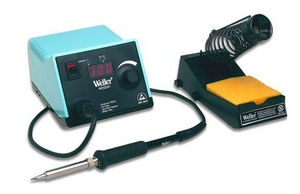Soldering Iron
From FamiLAB Wiki
The soldering iron is a bit of metal on a handle that gets up to about 700 degrees F and melts solder. You use it to solder circuit boards, namely components on those circuit boards.
Use
Caution! This thing gets really hot. 700F is enough to burn you pretty good, especially if you accidentally drop molten solder onto your leg. Make sure you're careful and use common sense with this tool.
While it's not rocket science, soldering does take some work to get the hang of. Try and take a soldering class, or get started on a 'learn to solder' kit. You'll be much happier you messed up on something that's not important. Believe us.
To use:
- Turn on the iron. Set the desired temperature. Most solders are designed for 700F. Set it to 800F for special high-temp solders or for when large amounts of solder need to be melted. Keep in mind that heat damages components, so the name of the game is getting in, soldering, and getting back out. Don't hold heat on the circuit board for too long or you'll start lifting pads and burning up components.
- Moisten the sponge. The only purpose of the water is to keep the sponge soft and keep it from burning. It should NOT be swimming in water or be dripping. Imagine wetting a sponge and then wringing every bit of water out with your hands. That's how wet the sponge should be. Any more and you're just shocking the tip and cooling it off when you're trying to keep it hot.
- Perform your soldering.
- TURN OFF THE IRON when you are finished.
- Make sure to set it in a way that the iron won't be bumped/tipped/exposed while it's cooling, so other lab members don't get burned, and so that other objects aren't melted/burned by the hot tip.
